CURSOR #19 – April 1980

COVER
Author: Peter Stearns
Original file name: COVER19
PRG file: cover19.prg
This month's cover is an animated depiction of the Penrose Stairs illusion, which many readers will know from M. C. Escher's famous lithograph Ascending and Descending. There a few small surprises that pop up as the animation unfolds, so you may want to watch this one all the way through.
Pressing SPACE takes you to the table of contents for the issue.
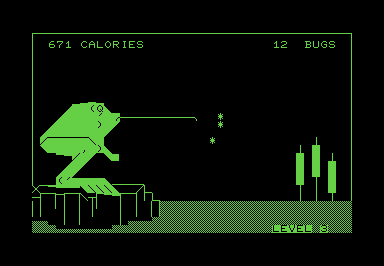
FROG!
Author: Bob Carr
Original file name: FROG!
PRG file: frog.prg
In FROG!, you take control of a frog, extending your tongue to catch bugs.
This game feels like it could be an ancestor of the Intellivision game
Frog Bog. I don't know
if FROG! inspired any later games, but this was the earliest example of the
"frog catching flies" genre that I could find.
Use the number keys to stretch your tongue to various heights and lengths. The timing is tricky at first but easy to get used to. Any attempt to catch a fly costs energy, so you can just go mindlessly shooting out your tongue. The key is to be patient, but not too patient, because if you wait too long, your frog will starve.
The PETSCII frog is large and detailed, and the gameplay, while simple, gets the job done. It's possible that without this game, we may never have seen the brilliant "educational" game Frog Fractions.
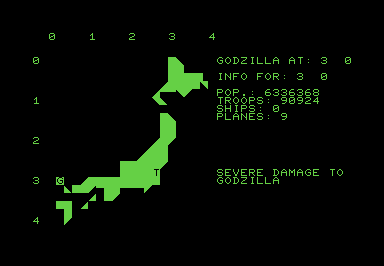
GODZILLA!
Author: Randall Lockwood
Original file name: GODZILLA!
PRG file: godzilla.prg
GODZILLA! is a turn-based strategy game in which you try to stop Godzilla from
rampaging across Japan. At your disposal are ground troops, ships, planes, missiles, and
a last-resort nuclear weapon. If Godzilla kills 20 million citizens, you lose the game. The
random number generation has a huge influence on the outcome. A single game can either be a
cakewalk or an impossible challenge depending upon how Godzilla chooses to move around the island.
The mechanics of the game are largely hidden from the player but I got the feeling that there is some hidden depth here. I had to spend a few games stumbling around the interface before I got a good handle on a winning strategy. In a contemporaneous issue of COMPUTE!, Marlene R. Pratto describes this game as one where kids (Grades 3–4) "learn the rules and strategies by playing the game", which is a fair assessment.
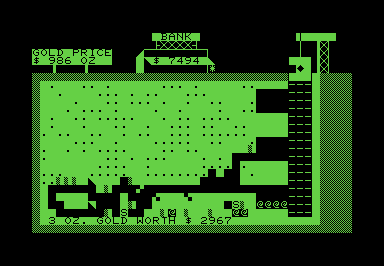
MINER!
Author: Ron Longfellow
Original file name: MINER!
PRG file: miner.prg
I loved MINER as a kid; I even went so far as to port it to the
Commodore 64 (although that version appears to be lost forever). In this game, you dig through
the mine looking for gold. Occasionally you encounter obstacles like cave-ins or flooding that
slow your progress. Overall, I think the game is too easy and the goal of earning $10,000 is
too forgiving, but in spite of its flaws, I keep coming back to play this one again and again.
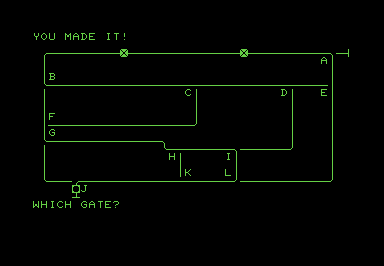
RAIL
Author: Chris Torkildson
Original file name: RAIL
PRG file: rail.prg
RAIL is a puzzle game in which a set of unstoppable trains move around a
map of tracks. Your goal is to guide one specially-marked train to a siding while operating
twelve track switches to prevent collisions and derailments. So far, I've managed to safely
guide the train with a total of four trains moving around the tracks—you can have up
to six trains in motion, so the game can get quite tricky. (Watch out for switchpoint 'J'
at the very beginning of the run.)
Owing to the limited RAM of the PET, there's only one track layout in the game. I think
RAIL could form the core of a much larger game, with levels and a progression
of more and more complicated track layouts as the difficulty increases. (There, a free
PET project idea for anyone who wants to steal it.)
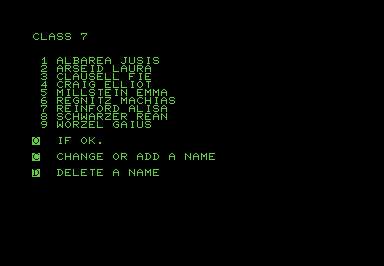
GBOOK
Author: Hal Carey
Original file names: GBOOKA and GBOOKB
PRG file (Part A): gbooka.prg
PRG file (Part B): gbookb.prg
GBOOK is a grade-keeping utility for teachers. The program is split into
two parts: GBOOKA allows you to create or edit class lists and save them to
a data file on tape, while GBOOKB allows you to enter grades for a student list
created with Part A. The student list creator program seems competent enough,
but without
a student list data file on tape
there's no way for me to evaluate the grade entry program. Even though I doubt anybody will run
these programs today—there are modern grade-book programs and even a simple Excel spreadsheet
is enough to get the job done—these programs represent the spirit of the early days of
personal computing: if you couldn't find a program to do what you wanted, you'd simply write your
own in BASIC.
